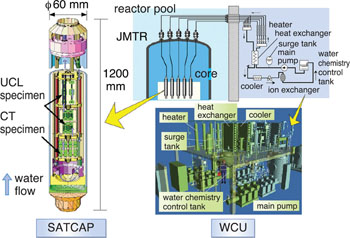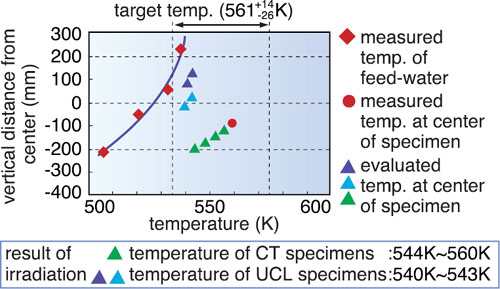The advanced water chemistry controlled irradiation research device (Fig. 11-1) has been developed and installed in the Japan Materials Testing Reactor (JMTR). This device was designed to simulate the BWR core environment. Therefore, it is possible to control the water chemistry, the irradiation temperature, and the water pressure of the test environment.
This device consists of the saturated temperature capsule (SATCAP), which contains several types of specimens, and the water control unit (WCU), which supplies high temperature and high-pressure water to the SATCAP. The WCU consists of the water supply system, the water chemistry control system, the water purification system and the water make up system. Using this device, simulation of typical BWR water chemistry is possible (Table 11-1).
Since the capsule type device was employed, neutron flux can be controlled by selecting the optimum irradiation hole in the JMTR core. If an irradiation hole at the fuel region were selected, neutron fluence of 3×1025 m-2 (3×1025 m-2 is the neutron fluence value at the shroud region for 60 years of BWR operation) can be achieved in 2 years.
The temperature of the specimens during the irradiation is an important point in the irradiation assisted stress corrosion cracking (IASCC) irradiation test. In the irradiation test, the temperature of specimens is controlled within the target range by changing the temperature and flow velocity of the feed-water as shown in Fig. 11-2. For the temperature evaluation of specimens, specimen types are considered in the evaluation method. The temperature of the compact tension (CT) specimen, which has a large volume, is determined from the measured temperature at the inside of the specimen and the temperature of the feed-water. On the other hand, that of the uniaxial constant load (UCL) specimen, which has a small volume, is determined from the feed-water temperature and the flow velocity.
Irradiation tests continue to achieve a neutron fluence of 1×1026 m-2. Upon reaching this exposure, the post-irradiated SATCAP is dismantled at the hot laboratory, and specimens are provided to the post-irradiation examination (PIE) for tensile tests, crack growth tests and so on. These PIE results are expected to contribute to the clarification of IASCC phenomenon.
|


